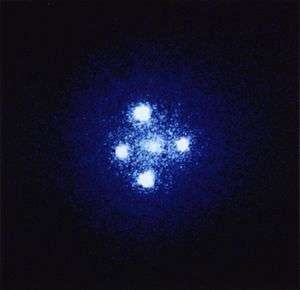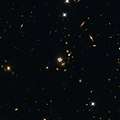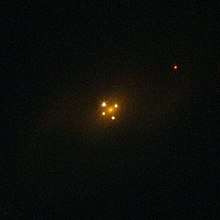Einstein Cross
The Einstein Cross (Q2237+030 or QSO 2237+0305) is a gravitationally lensed quasar that sits directly behind ZW 2237+030, Huchra's Lens. Four images of the same distant quasar (plus one in the centre, too dim to see) appear around a foreground galaxy due to strong gravitational lensing.[1][2] This system was discovered by John Huchra and coworkers in 1985.[3]
| QSO 2237+0305 | |
|---|---|
 | |
| Observation data (Epoch J2000) | |
| Constellation | Pegasus |
| Right ascension | 22h 40m 30.3s |
| Declination | +3° 21′ 31″ |
| Redshift | 1.695 |
| Distance | 8,000,000,000 ly (2,500,000,000 pc) |
| Type | LeQ |
| Apparent dimensions (V) | less than 2" |
| Apparent magnitude (V) | 16.78 |
| Other designations | |
| LEDA 69457, Z 378-15 | |
| See also: Quasar, List of quasars | |
Another Einstein cross (J2211-3050) discovery was announced March 18, 2019.[4]
While gravitationally lensed light sources are often shaped into an Einstein ring, due to the elongated shape of the lensing galaxy and the quasar being off-centre, the images form a peculiar cross-shape instead.[5]
Details
The quasar's redshift indicates that it is located about 8 billion light years from Earth, while the lensing galaxy is at a distance of 400 million light years. The apparent dimensions of the entire foreground galaxy are 0.87 × 0.34 arcminutes,[6] while the apparent dimension of the cross in its centre accounts for only 1.6 × 1.6 arcseconds.
The Einstein Cross can be found in Pegasus at 22h 40m 30.3s, +3° 21′ 31″.
Amateur astronomers are able to see some of the cross using telescopes; however, it requires extremely dark skies and telescope mirrors with diameters of 18 inches (46 cm) or greater.[7]
The individual images are labelled A through D (i.e. QSO 2237+0305 A), the lensing galaxy is sometimes referred to as QSO 2237+0305 G.
Gallery
 Lensed quasar HE0435-1223 and its surroundings.[8]
Lensed quasar HE0435-1223 and its surroundings.[8] Hubble Space Telescope captures Einstein Cross.
Hubble Space Telescope captures Einstein Cross.
See also
- Cloverleaf Quasar
- Einstein ring (Chwolson ring)
- Gravitational lensing
- Quasar
- SN Refsdal
- Twin Quasar
References
- NASA and ESA (September 13, 1990). "The Gravitational Lens G2237 + 0305". HubbleSite. Retrieved July 25, 2006.
- Drakeford, Jason; Corum, Jonathan; Overbye, Dennis (March 5, 2015). "Einstein's Telescope - video (02:32)". The New York Times. Retrieved December 27, 2015.
- Huchra, J.; et al. (1985). "2237 + 0305: A new and unusual gravitational lens". Astronomical Journal. 90: 691–696. Bibcode:1985AJ.....90..691H. doi:10.1086/113777.
- "A new Einstein cross is discovered". phys.org. Retrieved 2019-11-13.
- "How does gravitational lensing account for Einstein's Cross?". physics.stackexchange.com. Retrieved 2016-06-26.
- "LEDA 69457". SIMBAD. Centre de données astronomiques de Strasbourg. Retrieved 12 February 2017.
- Crinklaw, Greg. "Focus on Einstein's Cross". Retrieved 2013-06-29.
- "Cosmic lenses support finding on faster than expected expansion of the Universe". www.spacetelescope.org. Retrieved 27 January 2017.